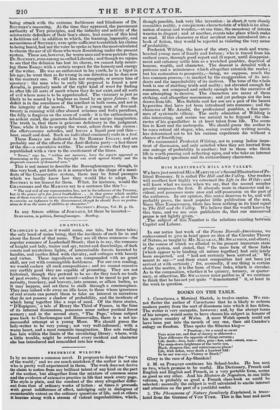CHANTILLY.
CHANTILLY is not, as it would seem, one tale, but three tales; the only bond of union being, that the incidents of each lie in and about the forest of that name. They are all three romances—the - regular romance of Leadenhall Street; that is to say, the romance of knight and lady, traitor and spy, turret and drawbridge, of dark courts and mysterious lights, of interminable forests haunted by bandits, and castles filled with chivalry, and cottages with beauty and virtue. These ingredients are compounded with no great skill, nor yet with contemptible feebleness. For our own reading, we would eschew all such compositions ; and we cannot conceive any earthly good they are capable of promoting. They are not historical, though they pretend to be so—for they teach no truth of past events; they are not moral—unless it be moral to put ge- nerosity, treachery, and bravery, into armour, or silken bodice, as it may happen, and set them to stalk through a commonplace. They may indeed wile away an idle hour, to those whose ignorance of real events can permit them to take an interest in narratives ' that do not possess a shadow of probability, and the incidents of which hang together like a rope of sand. Of the three stories, " D'Espignac," a tale of Henry the Third of France, in the time of its internal dissensions, possesses some rather poetical forest scenery; and in the second story, "The Page," whose subject ' goes back to Charlemagne and Roncesvalles, there is a not un- successful attempt at a young Moor. We should guess the lady-writer to be very young ; not very well-informed; with a warm heart, and a most romantic imagination. Her sole reading has .lain within the limits of the circulating library; where, with a little trouble, might be retraced every incident and character she has introduced and remoulded into her work.


























 Previous page
Previous page